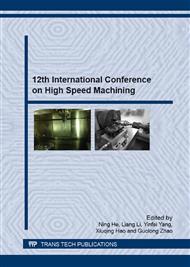[1]
Mo Jianhua, Ye Chunsheng, Huang Shuhuai, Chen Zhengdi, Yi Zhenming, Metal sheet numerical control incremental forming technology, Aviation Manufacturing Technology, 8 2002. (in Chinese).
Google Scholar
[2]
J. R. Duflou, B. Callebaut, J. Verbert, and H. De Baerdemaeker, Improved SPIF performance through dynamic local heating, International Journal of Machine Tools and Manufacture, vol. 48 (2008) No. 5, pp.543-549.
DOI: 10.1016/j.ijmachtools.2007.08.010
Google Scholar
[3]
G. Ambrogio, a, I. C. , b, L. D. N. , a, et al., Influence of some relevant process parameters on the dimensional, Journal of Materials Processing Technology, 56 (2004).
Google Scholar
[4]
G. Centeno, I. Bagudanch, A. J. Martínez-Donaire, M. L. García-Romeu, and C. Vallellano, Critical analysis of necking and fracture limit strains and forming forces in single-point incremental forming, Materials & Design, vol. 63 (2014), pp.20-29.
DOI: 10.1016/j.matdes.2014.05.066
Google Scholar
[5]
M. B. Silva and P. A. F. Martins. (2012, 4). Two-Point Incremental Forming with Partial Die: Theory and Experimentation.
Google Scholar
[6]
J. S. R. M. W. K. L. J. Cao, Deformation mechanics in single-point and accumulative double-sided incremental forming. pdf, Springer, 2 (2013).
Google Scholar
[7]
L. Montanari, V. A. Cristino, M. B. Silva, and P. A. F. Martins, A new approach for deformation history of material elements in hole-flanging produced by single point incremental forming, The International Journal of Advanced Manufacturing Technology, vol. 69 (2013).
DOI: 10.1007/s00170-013-5117-4
Google Scholar
[8]
C. Henrard, C. Bouffioux, P. Eyckens, H. Sol, J. R. Duflou, P. Van Houtte, et al., Forming forces in single point incremental forming: prediction by finite element simulations, validation and sensitivity, Computational Mechanics, vol. 47 (2010).
DOI: 10.1007/s00466-010-0563-4
Google Scholar
[9]
K. E. P. Hartley, An assessment of various process strategies for improving precision in single point incremental forming. pdf, springer, 21 (2010).
Google Scholar
[10]
I. Bagudanch, G. Centeno, C. Vallellano, and M. L. Garcia-Romeu, Forming Force in Single Point Incremental Forming under Different Bending Conditions, Procedia Engineering, vol. 63 (2013), pp.354-360.
DOI: 10.1016/j.proeng.2013.08.207
Google Scholar
[11]
K. Hamilton and J. Jeswiet, Single point incremental forming at high feed rates and rotational speeds: Surface and structural consequences, CIRP Annals - Manufacturing Technology, vol. 59 (2010) No. 1, pp.311-314.
DOI: 10.1016/j.cirp.2010.03.016
Google Scholar
[12]
J. Belchior, M. Guillo, E. Courteille, P. Maurine, L. Leotoing, and D. Guines, Off-line compensation of the tool path deviations on robotic machining: Application to incremental sheet forming, Robotics and Computer-Integrated Manufacturing, vol. 29 (2013).
DOI: 10.1016/j.rcim.2012.10.008
Google Scholar
[13]
Liu Wei, Zhang Hongying, Vibration plate progressive precision forming process and the analysis of deformation force, Heat Treatment Technology, 7 2010. (in Chinese).
Google Scholar
[14]
Zhang Shihong, Ultrasonic plastic processing of metallic materials, Metal Forming Technology, 32 1993. (in Chinese).
Google Scholar
[15]
P. A. F. Martins, N. Bay, M. Skjoedt, and M. B. Silva, Theory of single point incremental forming, CIRP Annals - Manufacturing Technology, vol. 57 (2008) No. 1, pp.247-252.
DOI: 10.1016/j.cirp.2008.03.047
Google Scholar
[16]
Zhou Liuru, Mo Jianhua, Xiao Xiangzhi, Research on the numerical control incremental forming process of sheet metal parts, Journal of Plastic Engineering, 27 2003. (in Chinese).
Google Scholar
[17]
P. Eyckens, J. Duflou, A. Bael, and P. Houtte, The significance of friction in the single point incremental forming process, International Journal of Material Forming, vol. 3 (2010), pp.947-950.
DOI: 10.1007/s12289-010-0925-7
Google Scholar
[18]
X. Ziran, L. Gao, G. Hussain, and Z. Cui, The performance of flat end and hemispherical end tools in single-point incremental forming, The International Journal of Advanced Manufacturing Technology, vol. 46 (2009), pp.1113-1118.
DOI: 10.1007/s00170-009-2179-4
Google Scholar


